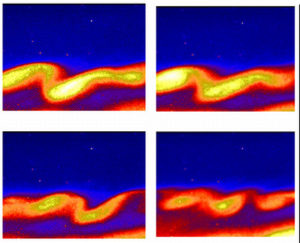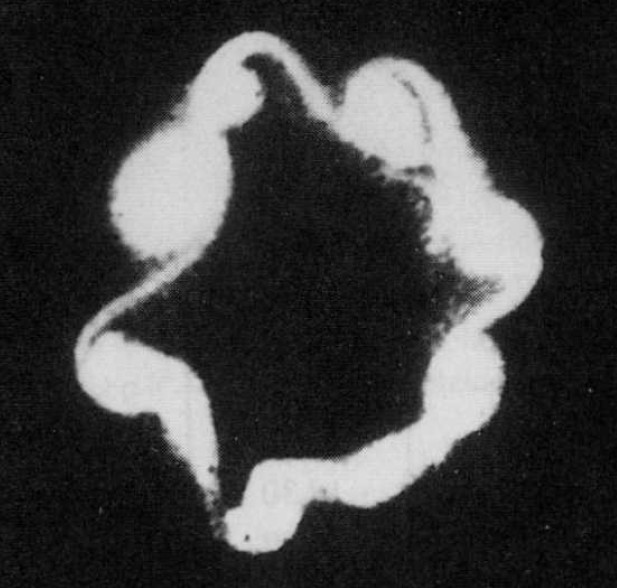The diocotron instability (also called the slipping stream plasma instability), is “one of the most ubiquitous instabilities in low density nonneutral plasmas with shear in the flow velocity [.. that can ..] occur in propagating non-neutral electron beams and layers”.[2] [3] It may give rise to electron vortices,[4], which resembles the Kelvin-Helmholtz fluid dynamical shear instability, and occurs when charge neutrality is not locally maintained.[5] The term diocotron derives from the Greek διωκειν, meaning “pursue.”[5]
Aurora

See image, right.
Galactic arms
The arms of galaxies (eg. NGC 3646) are susceptible to the diocotron instability [8] In the simulation of galaxy formation, Peratt found that:
- Since Ez is out of the plane of the page, the column electrons spiral downward in counter-clockwise rotation while the column ions spiral upward in clockwise rotation. A polarization induced charge separation also occurs in each arm, which, as it thins out, produces a radial electric field across the arm. Because of this field, the arm is susceptible to the diocotron instability. This instability appears as a wave motion in each arm.[9]
Pulsars
The Diocotron instability has also been associated with a pulsar’s electrosphere.[10]
Solar coronal waves
Recent waves discovered in the Sun’s corona,[11] are attributed to Kelvin-Helmholtz instabilities because the solar coronal plasma is generally considered to be neutral.[12]
References
- ↑ Trond Trondsen / Institute for Space Research, Calgary, Canada. See also.
- ↑ Ronald C. Davidson, “Physics of Nonneutral Plasmas”, Published 2001, Imperial College Press, 750 pages, ISBN 1860943039 (page 289) ACADEMIC BOOK
- ↑ R. H. Levy, “Diocotron Instability in a Cylindrical Geometry” Phys. Fluids 8, 1288 (1965); DOI:10.1063/1.1761400 PEER REVIEWED
- ↑ Mikhail V. Nezlin, “Physics of Intense Beams in Plasmas”, translated by E. W Laing and Vitaly I. Kisin, published 1993, CRC Press, ISBN 0750301864 (page 142) ACADEMIC BOOK
- ↑ 5.0 5.1 5.2 Anthony L. Peratt, Physics of the Plasma Universe Ch.1 Cosmic Plasma Fundamentals, 1.7.3 The Diocotron Instability, p.29 (1992) ACADEMIC BOOK
- ↑ T. S. Trondsen and L. L. Cogger “Fine-scale optical observations of Aurora“, Physics and Chemistry of the Earth, Part C: Solar, Terrestrial & Planetary Science, Volume 26, Issues 1-3, January 2001, Pages 179-188. See also papers by T. Hallinan, Refs 36-39
- ↑ Hannes Alfvén, Cosmical Electrodynamics (1950) International Series of Monographs on Physics, Oxford: Clarendon Press, 1950 ACADEMIC BOOK
- ↑ Anthony L. Peratt, Physics of the Plasma Universe Ch.3 Biot-Savart Law in Cosmic Plasma (1992) ACADEMIC BOOK
- ↑ Charles M. Snell and Anthony L. Peratt, “Rotation Velocity and Neutral Hydrogen Distribution Dependency on Magnetic Field Strength in Spiral Galaxies” FULL TEXT, Astrophysics and Space Science 227 (May 1995)], Proceedings Second IEEE International Workshop on Plasma Astrophysics and Cosmology (10-12 May 1993). (1995) PEER REVIEWED
- ↑ J. Pétri, “Relativistic stabilisation of the diocotron instability in a pulsar “cylindrical” electrosphere“, Astronomy & Astrophysics, 469, 843-855 (2007) DOI: 10.1051/0004-6361:20066985 PEER REVIEWED
- ↑ “NASA’s Solar Dynamics Observatory Catches “Surfer” Waves on the Sun“, 06.07.11
- ↑ Prof. Leon Ofman, private communication, 20 June 2011
